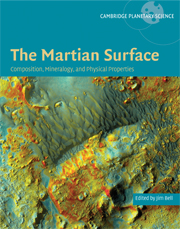Book contents
- Frontmatter
- Contents
- List of contributors
- Foreword
- Acknowledgments
- Part I Introduction and historical perspective
- Part II Elemental Composition: Orbital and in situ Surface Measurements
- Part III Mineralogy and Remote Sensing of Rocks, Soil, Dust, and Ices
- Part IV Physical Properties of Surface Materials
- Part V Synthesis
- 22 Implications of observed primary lithologies
- 23 Aqueous alteration on Mars
- 24 The sedimentary rock cycle of Mars
- 25 Martian polar processes
- 26 Astrobiological implications of Mars' surface composition and properties
- Part VI Summary, Upcoming Missions, and New Measurement Needs
- Index
- Plate section
- References
23 - Aqueous alteration on Mars
from Part V - Synthesis
Published online by Cambridge University Press: 10 December 2009
- Frontmatter
- Contents
- List of contributors
- Foreword
- Acknowledgments
- Part I Introduction and historical perspective
- Part II Elemental Composition: Orbital and in situ Surface Measurements
- Part III Mineralogy and Remote Sensing of Rocks, Soil, Dust, and Ices
- Part IV Physical Properties of Surface Materials
- Part V Synthesis
- 22 Implications of observed primary lithologies
- 23 Aqueous alteration on Mars
- 24 The sedimentary rock cycle of Mars
- 25 Martian polar processes
- 26 Astrobiological implications of Mars' surface composition and properties
- Part VI Summary, Upcoming Missions, and New Measurement Needs
- Index
- Plate section
- References
Summary
ABSTRACT
Aqueous alteration is the change in composition of a rock, produced in response to interactions with H2O-bearing ices, liquids, and vapors by chemical weathering. A variety of mineralogical and geochemical indicators for aqueous alteration on Mars have been identified by a combination of surface and orbital robotic missions, telescopic observations, characterization of Martian meteorites, and laboratory and terrestrial analog studies. Mineralogical indicators for aqueous alteration include goethite (lander), jarosite (lander), kieserite (orbiter), gypsum (orbiter) and other Fe-, Mg-, and Ca-sulfates (landers), halides (meteorites, lander), phyllosilicates (orbiter, meteorites), hematite and nanophase iron oxides (telescopic, orbiter, lander), and Fe-, Mg-, and Ca-carbonates (meteorites). Geochemical indicators (landers only) for aqueous alteration include Mg-, Ca-, and Fe-sulfates, halides, and secondary aluminosilicates such as smectite. Based upon these indicators, several styles of aqueous alteration have been suggested on Mars. Acid-sulfate weathering (e.g., formation of jarosite, gypsum, hematite, and goethite) may occur during (1) the oxidative weathering of ultramafic igneous rocks containing sulfides, (2) sulfuric acid weathering of basaltic materials, and (3) acid-fog (i.e., vapors rich in H2SO4) weathering of basaltic or basaltic-derived materials. Near-neutral or alkaline alteration occurs when solutions with pH near or above 7 move through basaltic materials and form phases such as phyllosilicates and carbonates. Very low water:rock ratios appear to have been prominent at most of the sites visited by landed missions because there is very little alteration (leaching) of the original basaltic composition (i.e., the alteration is isochemical or in a closed hydrologic system).
- Type
- Chapter
- Information
- The Martian SurfaceComposition, Mineralogy and Physical Properties, pp. 519 - 540Publisher: Cambridge University PressPrint publication year: 2008
References
- 27
- Cited by

